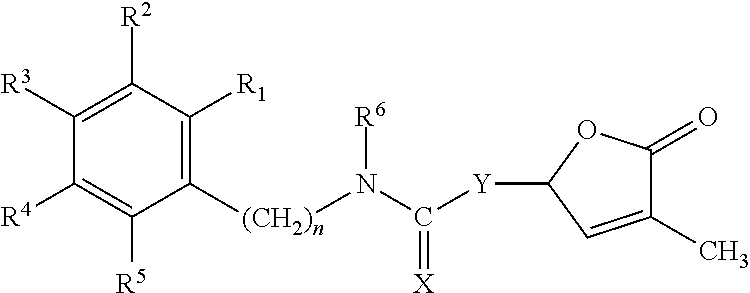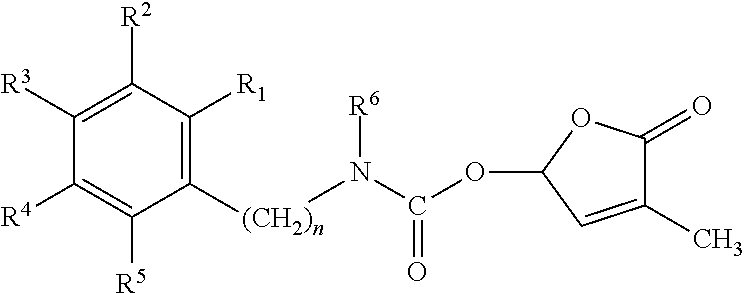Germination-stimulant carbamate derivatives and process for preparation thereof
a technology of carbamate and germination stimulation, which is applied in the field of new carbamate derivatives, can solve the problems of robbery of nutrients and water from agricultural crops, inability to stimulate the growth of agricultural crops, and large damage to agricultur
- Summary
- Abstract
- Description
- Claims
- Application Information
AI Technical Summary
Benefits of technology
Problems solved by technology
Method used
Image
Examples
production example 1
Synthesis of 4-methyl-5-oxo-2,5-dihydrofuran-2-yl phenylcarbamate (Compound No. 1)
[0097]In diisopropyl ether (10 ml), 3-methyl-5-hydroxybutenolide (0.800 g, 7.01 mmol) was stirred, and thereto was added with stirring triethylamine (5 to 6 drops), followed by phenyl isocyanate (0.700 g, 5.85 mmol). Then, the mixture was stirred overnight. After the completion of the reaction, the reaction solution was quenched with 1M hydrochloric acid, extracted with diethyl ether, and washed with saturated sodium chloride solution. The resulting organic layer was dried over magnesium sulfate, purified by a column chromatography to give the target compound (0.05 g).
[0098]Crystalline solid, m.p 112-115° C.
[0099]1H NMR (CDCl3): δ=2.00-2.01 (m, 3H), 6.92-6.96 (s, 1H), 7.25-7.36 (m, 6H)
production example 2
Synthesis of 4-methyl-5-oxo-2,5-dihydrofuran-2-yl benzylcarbamate (Compound No. 2)
[0100]Into diisopropyl ether (10 ml) was dissolved 3-methyl-5-hydroxybutenolide (1.14 g, 10.0 mmol), and thereto were added triethylamine (3 drops) and benzyl isocyanate (1.33 g, 10.0 mmol). Then, the mixture was stirred at room temperature overnight. After the completion of the reaction, the reaction solution was quenched with saturated ammonium chloride solution, extracted with ethyl acetate, and washed with saturated sodium chloride solution. The resulting organic layer was dried over magnesium sulfate, and purified by a column chromatography to give the target compound (0.98 g).
[0101]Crystalline solid, m.p 72-75° C.
[0102]1H NMR (CDCl3): δ=1.93-1.97 (m, 3H), 4.40-4.42 (m, 2H), 5.23 (br s, 1H), 6.86-6.90 (m, 1H), 7.26-7.38 (m, 6H)
production example 3
Synthesis of 4-methyl-5-oxo-2,5-dihydrofuran-2-yl phenethylcarbamate (Compound No. 3)
[0103]In diisopropyl ether (5 ml) was dissolved 3-methyl-5-hydroxybutenolide (0.44 g, 3.83 mmol), and thereto were added triethylamine (3 drops) and phenethylisocyanate (0.56 g, 3.83 mmol). Then, the mixture was stirred at room temperature overnight. After the completion of the reaction, the reaction solution was quenched with saturated ammonium chloride solution, extracted with ethyl acetate, and washed with saturated sodium chloride solution. The resulting organic layer was dried over magnesium sulfate, and purified by a column chromatography to give the target compound (0.34 g).
[0104]Crystalline solid, m.p 64-66° C.
[0105]1H NMR(CDCl3): δ=1.92 (s, 3H), 2.82-2.87 (m, 2H), 3.42-3.56 (m, 2H), 4.85 (br s, 1H), 6.83-6.87 (m, 1H), 7.18-7.34 (m, 6H)
PUM
| Property | Measurement | Unit |
|---|---|---|
| temperature | aaaaa | aaaaa |
| temperature | aaaaa | aaaaa |
| reaction temperature | aaaaa | aaaaa |
Abstract
Description
Claims
Application Information
 Login to View More
Login to View More - R&D
- Intellectual Property
- Life Sciences
- Materials
- Tech Scout
- Unparalleled Data Quality
- Higher Quality Content
- 60% Fewer Hallucinations
Browse by: Latest US Patents, China's latest patents, Technical Efficacy Thesaurus, Application Domain, Technology Topic, Popular Technical Reports.
© 2025 PatSnap. All rights reserved.Legal|Privacy policy|Modern Slavery Act Transparency Statement|Sitemap|About US| Contact US: help@patsnap.com



